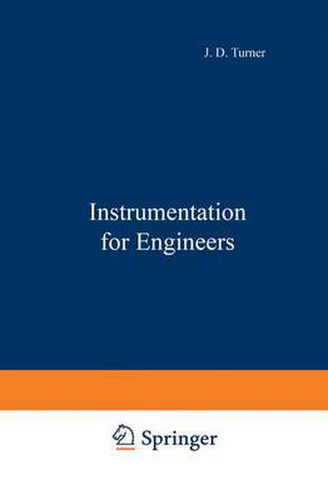Readings Newsletter
Become a Readings Member to make your shopping experience even easier.
Sign in or sign up for free!
You’re not far away from qualifying for FREE standard shipping within Australia
You’ve qualified for FREE standard shipping within Australia
The cart is loading…






This title is printed to order. This book may have been self-published. If so, we cannot guarantee the quality of the content. In the main most books will have gone through the editing process however some may not. We therefore suggest that you be aware of this before ordering this book. If in doubt check either the author or publisher’s details as we are unable to accept any returns unless they are faulty. Please contact us if you have any questions.
The science (or even the art!) of instrumentation is of fundamental import ance to engineers, scientists and medical workers. Instruments are the eyes and ears of the technologist. (His nose is reserved for detecting the effects of excess current. ) Without sensors and their associated signal processing systems there would be no modern transport, no National Grid distributing electricity, and anyone unlucky enough to fall ill would be offered only the most primitive medical treatment. The progress that has been made in almost all areas of technology can be seen in terms of the rate at which the necessary instrumentation has been developed. For example, in recent years many improvements have been made to the performance of the internal combus tion engine. More and more power has been squeezed out of smaller and more economic engines. One of the reasons is that in the last few years sensors have been developed which allow investigations to be made of the way in which the flame front spreads inside a cylinder after ignition. This work has led to a redesign of the geometry of the inlet valves and the piston, and more efficient engines are the result. The process of instrumentation is often considered solely in terms of the sensors used and their associated electronics. However, there are two steps involved in making any measurement. These are, first, getting the data, which is where sensors and electronics are used, and second, analysing it.
$9.00 standard shipping within Australia
FREE standard shipping within Australia for orders over $100.00
Express & International shipping calculated at checkout
Stock availability can be subject to change without notice. We recommend calling the shop or contacting our online team to check availability of low stock items. Please see our Shopping Online page for more details.
This title is printed to order. This book may have been self-published. If so, we cannot guarantee the quality of the content. In the main most books will have gone through the editing process however some may not. We therefore suggest that you be aware of this before ordering this book. If in doubt check either the author or publisher’s details as we are unable to accept any returns unless they are faulty. Please contact us if you have any questions.
The science (or even the art!) of instrumentation is of fundamental import ance to engineers, scientists and medical workers. Instruments are the eyes and ears of the technologist. (His nose is reserved for detecting the effects of excess current. ) Without sensors and their associated signal processing systems there would be no modern transport, no National Grid distributing electricity, and anyone unlucky enough to fall ill would be offered only the most primitive medical treatment. The progress that has been made in almost all areas of technology can be seen in terms of the rate at which the necessary instrumentation has been developed. For example, in recent years many improvements have been made to the performance of the internal combus tion engine. More and more power has been squeezed out of smaller and more economic engines. One of the reasons is that in the last few years sensors have been developed which allow investigations to be made of the way in which the flame front spreads inside a cylinder after ignition. This work has led to a redesign of the geometry of the inlet valves and the piston, and more efficient engines are the result. The process of instrumentation is often considered solely in terms of the sensors used and their associated electronics. However, there are two steps involved in making any measurement. These are, first, getting the data, which is where sensors and electronics are used, and second, analysing it.